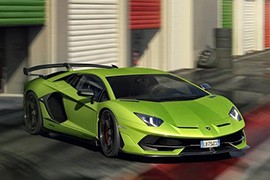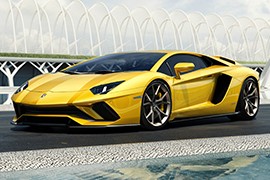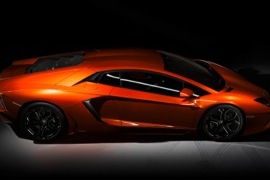LAMBORGHINI Aventador Models/Series Timeline, Specifications & Photos
First production year: 2011
Engines: Gasoline
Body style: Coupé (two-door)
It was the last Aventador, the car that should end the 11 years career of the Italian supercar career after many other special editions. Moreover, it was the final Lamborghini fitted with a naturally aspirated V12 engine.
As time went by, Lamborghini adopted the strategy of creating special models, which were sold with a lot more money than the regular versions. Although, sometimes, these special editions were not as special as the vehicles they derived from.
The Ultimae received a redesigned front bumper that increased the downforce. In addition, a splitter and an open air intake optimized the aerodynamics. On the sides, the Ultimae sported the same angular-shaped air intakes for the engine, placed behind the doors but adorned with unique decals. At the back, a three-position active aerodynamic wing kept the car planted on the road at high speeds and at high-speed cornering maneuvers.
Inside, the cockpit resembled the same fighter-jet-inspired atmosphere, with sport bucket seats deeply sculptured with a Y-pattern on the leather upholstery. The contrast stitching made that even more obvious. At the same time, the Lamborghini logos on the headrests completed the unique image of the Ultimae.
The Ultimae features a V12 engine behind the cabin like any other Aventador. But, unlike the rest of the range, it offered 780 PS (770 hp) at a sky-high rev range. It was still mated to the same seven-speed (dual-clutch) automatic gearbox and sends the power in all corners. While it's not way faster than the Aventador S, the Ultimae was lighter and nimbler on the race track than its sibling.
The Lamborghini Aventador SVJ was showed at the 2018 Monterey Car Week in California and with its limited 900 units production, it will be a collectible vehicle. But a very fast one.
The name stood for Super Veloce Jota, which can be translated in Super-fast Jota. The Jota suffix denoted the track-oriented vehicle. But it wasn't just a name. The anti-roll bar stiffness has been improved by 50% compared to the Aventador SV, which was already a Super-fast version of the already fast Aventador. The 7-speed dual-clutch gearbox was retuned for the increased power and torque and the all-wheel-drive system had improved torque split to maximize traction and handling.
The Aventador was not a new vehicle in 2018, but still a respectable car in the fast car world. The limited-edition SVJ took the car to a different level after it broke the Nurburgring lap record for a series production vehicle. Its 6:44.97 minutes time was hard to beat by anyone. In order to achieve that time, the vehicle featured numerous updates.
One of them was the ALA system, which stands for Aerodinamica Lamborghini Attiva. An advanced active aerodynamic system that opened and closed various flaps and wings depending on the driving speed and conditions. Some were meant for increase speed, some for downforce. The front bumper was wider and included side fins and new intakes.
Another special edition, named SVJ 63 played homage to the foundation of the Lamborghini company, in 1963. It had extensive use of carbon-fiber and it was built in a limited number of 63 units.
Lamborghini is known for building more special series from the same base product and that was the case with the Aventador which, in 2017, was introduced in the S-version with 740 hp.
After it was taken over by the Volkswagen Group, the Lamborghini car-maker started to increase its model range and to diversify each and every model it had on its stable. After six years since it was launched the Aventador received an important upgrade with the S version.
The exterior design was modified to improve the aerodynamics and the aggressive look. In the front, a new spoiler with body-color and carbon-fiber elements were blended in. From the side, the redesigned rear wheel arch resembled the one from the Countach. In the rear, the center-mounted exhaust was comprised of three angular-shaped pipes into a big, hexagonal, shape. A rear diffuser was installed under the bumper to reduce the ground effect.
The interior was not very much changed. It still looked like a cockpit from a fighter-jet, with toggle switches and a flap above the engine start button. The bucket-seats were covered in leather and bolstered for side support. The infotainment unit was little upgraded from the original, 2011, Aventador.
The most important was the 6.5-liter V12 engine placed in front of the rear axle. It was mated to a standard Lamborghini lightweight Independent Shifting Rod (ISR) 7-speed shifting system. The all-wheel-drive and all-wheel-steering super-car was able to hit the 60 mph (96 kph) in under three seconds.
Some of the boys who had the Countach posters on their walls grew up and in 2016 they could afford the true offspring of that supercar. And that was the 2016 Lamborghini Aventador SV LP750-4.
The Y shapes were everywhere present on the supercar. On the short trunk lid upfront, on the fenders, on the 3D front spoiler, and the LED taillights. The angry headlights were full LED and the fixed carbon-fiber wing in the back meant business.
Sometimes, a special edition of a supercar is just some nicer wheels and special colors. Not the case for the SV LP-750-4. The name said it all: 750 hp and all-wheel-drive. The SV meant Superveloce that can be translated in Superfast. To live up to that name, the Lamborghini engineers added 50 more hp to the Aventador and shaved 50 kg (110 lbs) from its weight. It wasn't only a diet, but a training program. While the removal of the ALA (Lamborghini Active Aerodynamic) cut some weight, then added some kilos in the form of adaptive steering and the magnetorheological dampers. That's where most of the USD 100.000 price difference was spent. The 600 units were produced and sold by July 2017.
As a result, the car was incredibly fast. On the Nurburgring Nordschleife race track, it ran a little bit slower than the USD 1.000.000 Porsche 918 hybrid supercar.
Lamborghini unleashed its creative power and introduced the Aventador in 2011, sending the decade-old Murcielago to a well-deserved retirement.
It was a new chapter from the book of Lamborghini's creations opened for the first time in 1966 by the Miura, the first V-12, mid-engined vehicle. The car defined all the supercars that followed and introduced the standard for all the high-performance sports cars that followed, either produced by Ferrari, McLaren, Spyker, or Koenigsegg, to name just a few. The only exception was the Porsche 911, but its sibling, the GT1, had the engine placed between the rear axle and the cockpit. After the Miura, the Countach, the Diablo, and the Murcielago raised the bar for everyone. And then, in 2011, from the gates of Lamborghini's factory from Sant'Agata Bolognese came the Aventador.
The F-117 Stealth Fighter-jet inspired its look. The wedged-shaped supercar featured Y-shaped daytime running lights, and a V-shaped front side pointed toward the road. Its wide, hexagonal air intakes from the bumper resembled those from a fighter jet. From its sides, the very raked windshield left very little headroom inside. The carmaker made two bubbles on the roof for the driver and passenger. The angular shapes continued on the engine lid, which featured a transparent polycarbonate cover above the V-12 mill.
Filippo Perini, the original project designer, was inspired by military aviation when he made the interior. All buttons and switches looked military-grade, and he didn't use any plastic parts for them. Moreover, the start button was covered by a flip-up red cap, similar to those that prevented accidental launches of a rocket because that was the Aventador, a ground-to-ground wheeled missile.
Behind the cabin, Lamborghini installed a newly developed 6.5-liter engine naturally aspirated that provided 690 hp to a seven-speed automatic (single-clutch) gearbox developed by Graziano Transmissioni. Its push-road independent suspension in all corners helped the car to stay on the road during high-speed cornering. And if that wasn't enough, an adaptive aerodynamic system increased the downforce.




